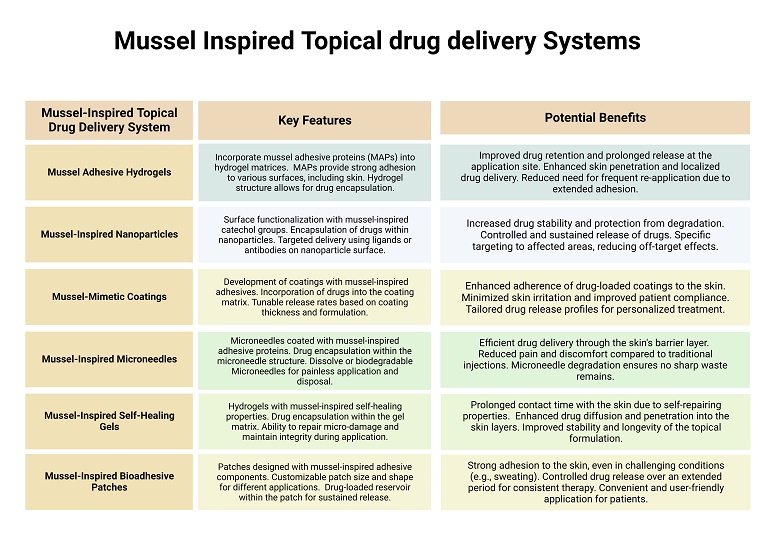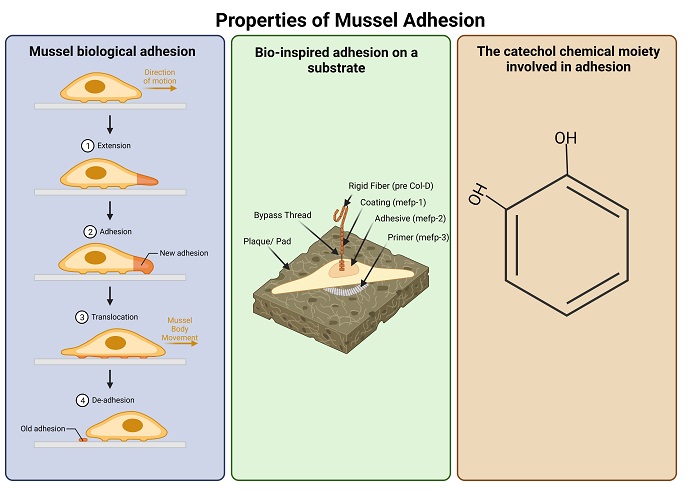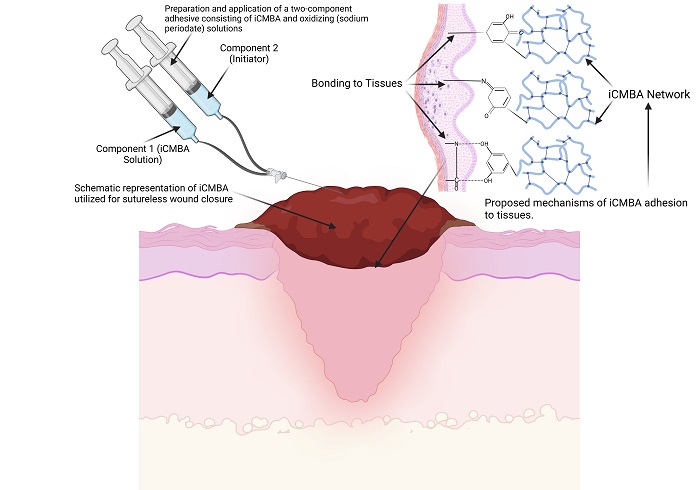Mussel-inspired bio-adhesive gels, utilising catechol-containing compounds, provide strong and reversible adhesion to the skin. They enhance drug retention, enabling sustained release for applications in wound healing, scar management, and targeted transdermal drug delivery in dermatology. Further research aims to optimise formulation strategies, improve biocompatibility, and enhance therapeutic efficacy.
1. INTRODUCTION
Topical drug delivery is a crucial approach in dermatology for treating various skin conditions effectively. But the conventional formulations often face challenges, including poor drug retention, limited penetration through the skin barrier, and the need for frequent application, leading to patient non-compliance. To address these issues, researchers have turned to nature for inspiration and developed innovative solutions, such as mussel-inspired bio-adhesive gels. Mussels are marine organisms that adhere firmly to various surfaces in the intertidal zone, even amidst strong waves and currents. Their adhesion is attributed to catechol-containing compounds found in the adhesive proteins secreted by the mussels. These compounds create strong interactions with both organic and inorganic surfaces, enabling reversible adhesion. Drawing from this natural phenomenon, scientists have sought to harness the adhesive properties of mussels to create bio-adhesive gels for medical applications.
1.1 Drug Delivery Challenges in Dermatology
Traditional topical drug delivery methods often encounter hurdles in dermatology due to the skin's complex structure. The stratum corneum, the outermost layer of the skin, serves as a formidable barrier, limiting drug permeation into deeper skin layers. Additionally, factors like sweating, sebum production, and environmental exposure can further reduce drug retention and efficacy. Moreover, certain dermatological conditions, such as chronic wounds or psoriatic plaques, pose unique challenges in maintaining drug contact with the affected area.
1.2 Advantages of Bio-adhesive Gels
Bio-adhesive gels inspired by mussel adhesion offer several advantages over conventional topical formulations. Firstly, their strong and reversible adhesion to the skin ensures prolonged drug contact, leading to enhanced drug retention at the site of application. This feature enables sustained drug release, reducing the need for frequent reapplication and improving patient compliance. Furthermore, these gels can be tailored to achieve controlled drug release profiles, allowing for targeted and localised therapy. By overcoming the limitations posed by the skin barrier, bio-adhesive gels enable improved penetration of therapeutic agents into deeper skin layers, maximising their therapeutic potential. Moreover, the biocompatibility of the mussel-inspired gels minimises the risk of adverse reactions, making them suitable for long-term dermatological applications. Some of Mussel Inspired Topical drug delivery system are shown in figure 1.

Figure 1. Key features of Mussel Inspired Topical drug delivery system
THE SCIENCE BEHIND MUSSEL-INSPIRED BIO-ADHESIVE GELS
2.1 Catechol-Containing Compounds and Their Role
Catechol-containing compounds play a pivotal role in the adhesive power of mussel-inspired bio-adhesive gels. Catechols are organic compounds characterised by a benzene ring bearing two hydroxyl groups. In mussels, these catechol groups are found in adhesive proteins, such as mussel foot proteins (Mfps), secreted by specialised adhesive glands. The catechols facilitate strong and versatile interactions with various surfaces, both organic and inorganic, through a process known as "metal coordination" or "chelation." The unique chemistry of catechols allows them to form coordination complexes with metal ions, such as iron and calcium, present in the surface of substrates. These metal-coordinated bonds create robust adhesive interactions, enhancing the gel's ability to stick to surfaces, including the skin. Moreover, the reversibility of these interactions ensures that the gel can be easily detached and re-adhered when required.
2.2 Bio-Adhesion Mechanism
The bio-adhesion mechanism of mussel-inspired gels is a multi-step process that begins with the exposure of catechol-containing moieties to the surface of interest as shown in Figure 2. Upon contact with the substrate, the catechols initiate the metal coordination process, forming adhesive bonds with available metal ions. The high affinity of catechols for metal ions ensures strong and rapid adhesion. Simultaneously, the gels can conform to irregular surface topographies, further augmenting their adhesive capabilities. This property is particularly advantageous for dermatological applications, as it allows the gel to adhere effectively to the uneven and complex skin surfaces.

Figure 2. Mechanism and Properties of Mussel Adhesion
2.3 Key Properties of Mussel-Inspired Adhesives
Mussel-inspired bio-adhesive gels possess several key properties that contribute to their effectiveness in drug delivery for dermatological applications. Firstly, their adhesion strength is remarkable, enabling secure attachment to the skin, even in challenging conditions such as high humidity or during physical activity. Secondly, these gels exhibit excellent shear and tensile strengths, ensuring that they can withstand mechanical stresses without losing adhesion. This property is crucial for maintaining long-lasting contact with the skin, essential for sustained drug delivery. Thirdly, mussel-inspired adhesives demonstrate biocompatibility and non-toxicity, making them safe for use in medical settings. These gels have shown minimal inflammatory responses and are well-tolerated by the skin, minimising the risk of adverse reactions.
3. APPLICATIONS IN DERMATOLOGY
Mussel-inspired bio-adhesive gels have shown great potential in various dermatological applications, revolutionising topical drug delivery and improving patient outcomes.
3.1 Wound Healing
3.1.1 Bio-Adhesive Gels for Improved Wound Closure
Bio-adhesive gels provide a unique advantage in wound healing by adhering firmly to the wound site, sealing it effectively. This property prevents the entry of foreign particles, bacteria, and pathogens, reducing the risk of infection and promoting a sterile environment conducive to healing. The gel's flexibility and conformability also facilitate wound closure on irregularly shaped wounds, such as those in contoured areas or surgical incisions. Yang et al. have recently introduced a ground breaking innovation - injectable citrate-based mussel-inspired bioadhesives as shown in Figure 3 . These adhesives, in the form of biodegradable and strong wet-tissue adhesives, offer a remarkable solution for closing bleeding wounds effectively, promoting tissue regeneration, all without the need for surgical tools. The versatility of these adhesives allows for their application in various surgical practices, both topical and non-topical. This novel technology opens up possibilities in multiple surgical disciplines, providing a viable alternative to traditional sutures or staples. For instance, it can be used for tissue grafts to treat hernias, ulcers, and burns, as well as for haemostatic wound dressings during laparoscopic partial nephrectomy. These adhesives serve as waterproof sealants for vascular anastomoses and offer effective treatment for gastrointestinal issues, such as fistulas, leaks, mucosal oozing, bleeding, and perforations. By eliminating the need for surgical tools, the injectable citrate-based mussel-inspired bioadhesives offer improved ease of application, reduced invasiveness, and enhanced patient outcomes. Their potential impact in the field of surgical practice is immense, as they present a versatile and efficient solution for wound closure and tissue repair in diverse clinical scenarios.

Figure 3. Representation of the injectable citrate-based mussel-inspired bioadhesives (iCMBA) application for wound closure
3.1.2 Accelerated Healing and Reduced Infections
The presence of catechol-containing compounds in the gel accelerates wound healing through metal coordination with metal ions present in the wound bed. This interaction promotes cell adhesion, migration, and proliferation, crucial for tissue regeneration and wound closure. Moreover, the adhesive gel's sustained drug release capability allows the controlled delivery of antimicrobial agents, further reducing the risk of infections during the healing process.
3.2 Scar Management
3.2.1 Minimising Scar Formation
Mussel-inspired gels have demonstrated efficacy in minimising scar formation by maintaining a moist wound environment that supports optimal collagen deposition and organisation. The gels' ability to prevent wound contraction and excessive scarring contributes to improved cosmetic outcomes and functional tissue restoration.
3.2.2 Scar Remodelling and Smoothing
These bio-adhesive gels can also aid in scar remodelling and smoothing by facilitating the breakdown and reorganisation of collagen fibres in the scar tissue. The controlled release of growth factors and bioactive compounds promotes collagen remodelling, leading to softer, less raised, and more aesthetically pleasing scars.
3.3 TRANSDERMAL DRUG DELIVERY
3.3.1 Overcoming Barriers in Transdermal Delivery
Transdermal drug delivery using mussel-inspired bio-adhesive gels overcomes the challenges posed by the skin's stratum corneum, which typically limits drug penetration. The adhesive properties of the gel ensure prolonged contact with the skin, facilitating enhanced drug permeation through the skin barrier.
3.3.2 Controlled and Targeted Drug Release
The tuneable drug release profiles of these gels enable controlled and targeted delivery of therapeutic agents. This precise drug delivery allows for localised treatment, reducing systemic side effects and optimising therapeutic efficacy for dermatological conditions like psoriasis, eczema, and localised pain management.
FORMULATION STRATEGIES FOR MUSSEL-INSPIRED GELS
Formulation strategies play a critical role in optimising the performance of mussel-inspired bio-adhesive gels for dermatological applications. Biomaterial Selection and Optimisation involves choosing suitable polymers and cross-linkers to create gels with desirable adhesive and mechanical properties. The selection of appropriate biomaterials ensures biocompatibility, stability, and compatibility with therapeutic agents. Incorporating Therapeutic Agents is essential for tailoring the gels to specific dermatological conditions. Small molecules like antibiotics or anti-inflammatory drugs can be directly incorporated into the gel matrix, while peptides and proteins may require more sophisticated delivery strategies to preserve their stability and bioactivity. Modulating Drug Release Profiles is achieved by manipulating the gel composition, including polymer ratio, cross-linking density, and drug loading. The incorporation of stimuli-responsive components, such as pH or temperature-sensitive moieties (Temperature and pH Responsiveness), enables on-demand drug release, triggered by the specific conditions at the target site. These formulation strategies collectively enable the design of mussel-inspired bio-adhesive gels that not only adhere strongly to the skin but also deliver therapeutic agents with controlled release kinetics, promising enhanced efficacy in dermatological treatments. Continued research in this field will further refine these strategies, advancing the application of these innovative gels in clinical settings.
5. BIOCOMPATIBILITY AND SAFETY CONSIDERATIONS
5.1 Evaluating Biocompatibility of Mussel-Inspired Gels
Ensuring the biocompatibility of mussel-inspired bio-adhesive gels is of paramount importance before clinical use. Comprehensive in vitro and in vivo studies are conducted to assess potential adverse effects on human tissues and cells. Researchers analyse parameters such as cytotoxicity, cell viability, and tissue responses to ensure the gels' non-toxic nature and compatibility with the skin. These evaluations provide critical insights into the gels' biocompatibility and their potential to promote tissue healing without causing harm.
5.2 Allergenicity and Sensitisation Concerns
As with any medical product, allergenicity and sensitisation concerns are addressed to safeguard patient safety. Some individuals may exhibit allergic reactions to specific components of the gel, particularly catechol-containing compounds. Sensitivity testing is conducted on a diverse patient population to identify potential allergens and minimise the risk of adverse reactions. This rigorous assessment ensures that the gels can be safely used on a broad range of patients without causing allergic responses.
5.3 Long-term Safety Assessments
Long-term safety assessments are essential to monitor the gels' performance and potential side effects over extended periods of use. Researchers conduct follow-up studies to evaluate the gels' biostability, biodegradation, and overall long-term safety profile. These assessments provide valuable data on the gels' stability in the body, the persistence of adhesive properties, and any potential accumulation of degradation by-products. By monitoring the gels' safety over time, researchers can ensure their suitability for prolonged applications in dermatological treatments with minimal risks to patients.
6. ENHANCED THERAPEUTIC EFFICACY
Mussel-inspired bio-adhesive gels offer a platform for enhancing the therapeutic efficacy of dermatological treatments through various strategies.
6.1 Improving Drug Bioavailability
By providing prolonged and intimate contact with the skin, these gels improve drug bioavailability, ensuring a more efficient delivery of therapeutic agents. The adhesive properties of the gels enable sustained release of drugs, allowing for a continuous supply of medications to the target site. This sustained drug release mechanism not only reduces the frequency of application but also maintains optimal drug concentrations at the site of action, leading to improved treatment outcomes.
6.2 Tailoring Gels for Specific Dermatological Conditions
Mussel-inspired gels can be tailored to address specific dermatological conditions, offering targeted and customised therapies.
6.2.1 Acne Treatment
In acne management, the gels can incorporate anti-inflammatory agents and antimicrobial compounds to combat acne-causing bacteria. The adhesive properties of the gels ensure better penetration of these agents into the hair follicles and sebaceous glands, effectively treating acne lesions.
6.2.2 Psoriasis Management
For psoriasis management, the gels can be loaded with corticosteroids, calcineurin inhibitors, or immunomodulators. These drugs target the immune dysregulation underlying psoriasis and, when delivered via the adhesive gels, improve drug retention and localised efficacy, reducing psoriatic plaques.
6.2.3 Eczema Relief
Mussel-inspired gels can soothe and hydrate eczema-affected skin by incorporating moisturising agents and anti-inflammatory compounds. The gels' ability to adhere to the skin prevents the loss of moisture and enhances the absorption of therapeutic agents, alleviating eczema symptoms.
6.3 Combination Therapies with Mussel-Inspired Gels
Combination therapies are increasingly explored to enhance treatment outcomes, and mussel-inspired gels serve as an excellent platform for combination therapies. By incorporating multiple therapeutic agents into the gels, synergistic effects can be achieved, targeting multiple pathways and aspects of a dermatological condition. For instance, combining antimicrobial agents with anti-inflammatory drugs in acne treatment can effectively tackle both bacterial infection and inflammation, resulting in improved acne management.
7. FUTURE DIRECTIONS AND CHALLENGES
The future of mussel-inspired bio-adhesive gels holds exciting possibilities in terms of technological advancements. Continued research and development are expected to refine the gel formulations, optimising adhesive properties, drug release kinetics, and biocompatibility. Innovations in materials science and nanotechnology may lead to the design of more sophisticated gels with enhanced functionalities, allowing for even better tailored and effective treatments in dermatology. With advancements in medical technology, the application of personalised medicine in dermatology is gaining prominence. Mussel-inspired gels offer a promising platform for patient-specific treatments, where formulations can be tailored to individual needs, considering factors such as skin type, disease severity, and drug response. Personalised treatments have the potential to improve treatment outcomes and patient satisfaction, driving the future of dermatological therapies. As mussel-inspired bio-adhesive gels move closer to clinical applications, addressing regulatory considerations and market adoption becomes crucial. Complying with rigorous safety and efficacy standards set by regulatory authorities is essential to gain approval for medical use. Additionally, the successful adoption of these gels in the market would depend on factors such as cost-effectiveness, ease of use, and acceptance by healthcare practitioners and patients. Overcoming these challenges will pave the way for the widespread integration of these innovative gels into mainstream dermatological treatments.
REFERENCES
Pandey, N., Soto-Garcia, L. F., Liao, J., Zimmern, P., Nguyen, K. T., & Hong, Y. (2020). Mussel-inspired bioadhesives in healthcare: design parameters, current trends, and future perspectives. Biomaterials science, 8(5), 1240-1255.
Mehdizadeh, M.; Weng, H.; Gyawali, D.; Tang, L.; Yang, J. Injectable citrate-based mussel-inspired tissue bioadhesives with high wet strength for sutureless wound closure. Biomaterials 2012, 33, 7972–7983.
Du, D., Chen, X., Shi, C., Zhang, Z., Shi, D., Kaneko, D., ... & Hua, Z. (2021). Mussel-inspired epoxy bioadhesive with enhanced interfacial interactions for wound repair. Acta Biomaterialia, 136, 223-232.
Wang, L., Xu, J., Xue, P., Liu, J., Luo, L., Zhuge, D., ... & Xu, H. (2021). Thermo-sensitive hydrogel with mussel-inspired adhesion enhanced the non-fibrotic repair effect of EGF on colonic mucosa barrier of TNBS-induced ulcerative colitis rats through macrophage polarizing. Chemical Engineering Journal, 416, 129221.
Wang, L., Xu, J., Xue, P., Liu, J., Luo, L., Zhuge, D., ... & Xu, H. (2021). Thermo-sensitive hydrogel with mussel-inspired adhesion enhanced the non-fibrotic repair effect of EGF on colonic mucosa barrier of TNBS-induced ulcerative colitis rats through macrophage polarizing. Chemical Engineering Journal, 416, 129221.
Zhu, J., Zhong, K., Zong, Y., Wang, S., Yang, H., Zhen, L., ... & Li, J. (2022). A mussel-inspired wet-adhesion hydrogel with hemostasis and local anti-inflammation for managing the development of acute wounds. Materials & Design, 213, 110347.
Han, S. Y., An, S., & Cho, S. W. Advanced Bio‐Adhesive Hydrogels for Skin Care and Therapy. Advanced Therapeutics, 2300125.
Pei, X., Wang, J., Cong, Y., & Fu, J. (2021). Recent progress in polymer hydrogel bioadhesives. Journal of Polymer Science, 59(13), 1312-1337.
Sun, C., Zeng, X., Zheng, S., Wang, Y., Li, Z., Zhang, H., ... & Yang, X. (2022). Bio-adhesive catechol-modified chitosan wound healing hydrogel dressings through glow discharge plasma technique. Chemical Engineering Journal, 427, 130843.
Chopra, H., Kumar, S., & Singh, I. (2020). Bioadhesive hydrogels and their applications. Bioadhesives in Drug Delivery, 147-170.